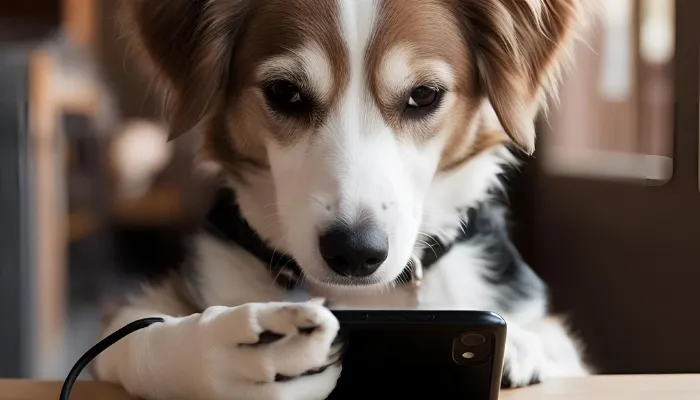Dogs are very different when it comes to communication as it differs from that of humans, which leads to questions like “How do dogs say “sorry”?” They don’t use words like us but gestures determined by actions and skin do the work for them. If you have ever scolded your dog and gave them the puppy eyes, they may be saying sorry. Some take it a step further and try to use a dog translator to better connect and understand their dog. From a dog’s perspective – how exactly do they apologize? Let’s have a look.

Signs That a Dog is Apologizing
Forgiveness from a dog is not verbal, but is more to do with their body movement and passive attitude. Here is how you can find out made my your dog is barking out an apology:
- Tail Tucking: By tucking their tail, dogs show bowing to authority, acceptance of defeat and regret.
- Avoiding Eye Contact: Looking away suggests that the dog respects you and knows that he or she is in the wrong.
- Licking or Nuzzling: If your dog nudges or gives a subtle lick to your palm, it is agitating affection and can come in terms with you.
- Whining or Whimpering: Gentle and low pitch whining is a way of utterance as dogs do to show how sorry and remorseful they are.
- Rolling Over: This move, which includes exposing the belly, is an act of submission and regret.
Dogs express remorse through body language, not words. Understanding these signs helps strengthen your bond. Ever wondered how do dogs say “sorry”? Their actions speak louder than barks!
How Dogs Apologize vs. Humans?
Ever wondered how do dogs say “sorry”? Unlike humans, their apologies rely on body language and subtle cues. Comparing canine and human remorse reveals key differences in how regret is expressed.
Let’s compare how dogs apologize versus how humans do:
| Action | Human Apology | Dog Apology |
|---|---|---|
| Words | “I’m sorry” | No words, just body language |
| Eye Contact | Direct | Avoids eye contact |
| Physical Cues | Hug, handshake | Licking, tail tucking |
| Vocalization | Speaking in a remorseful tone | Whining or whimpering |
Dogs communicate regret through actions, not words. Recognizing their signals strengthens the bond between you.
Why Do Dogs Apologize?
How do dogs say “sorry”? They do it not because they understand human rules but because they react to your tone and body language. Here’s why they apologize:
- Understanding Social Hierarchy – Dogs recognize their owners as the leader of the pack. Showing submission is a way to maintain harmony.
- Reacting to Your Mood: They can read human emotions, which makes them perform so calming tricks when you are angry.
- Learning from Past Reactions: A dog that has faced scolding deduction in the past modifies their behavior to avoid negative responses.
Dogs respond to your emotions, not rules, shaping their actions to maintain harmony. Their apologies come from instinct and learned behavior, not guilt. Understanding how do dogs say “sorry” deepens your connection with them.
How to Respond When Your Dog Apologizes?
Apology from a dog can be an interesting psychological and behavioral phenomenon. Here is how you can elicit and reinforce it to portray a more domesticated and mellow version of the dog.
- Stay Calm: Yelling will always create anxiety, and anxiety does not resolve any issues.
- Give Positive Reinforcement: A gentle pat or good dog will suffice in case of unintended behavior from your dog.
- Avoid Prolonged Punishment: If the punishment is simply arbitrary in instance where they have no clue what is wrong, it’s best to avoid it altogether.
- Use Commands to Teach Right from Wrong: Pouring scolding with a dash of warmth will assist in teaching the command firmly yet gently.
Responding calmly helps your dog learn and feel secure. Reinforcing good behavior strengthens your bond and understanding.
Common Misconceptions About Dog Apologies
There are several myths about how dogs apologize. Let’s clear up some misconceptions:
1. Do Dogs Actually Feel Guilt?
The questions most often that arise are revolving around chances of pets losing their owners and dogs don’t feel all that differently, it is simply their social conditioning. But animals pick human behavioral traits to respond, and research suggests that dogs don’t experience guilt like us but instead, respond to their owners actions.
2. Is a Guilty Look Always an Apology?
No. Even if some canines appear to look guilty, does not mean they have done a wrong in the first place. Most of probably, their reaction is simply because of the attitude and tone they are subjected to by their owners.
3. Is Teaching a Dog to Apologize Possible?
Undoubtedly, a dog can be “trained” to respond in a particular manner, but the actual act of genuinely “apologizing” is more a part of the dog’s instinct than learning. This primitive instinct seems to be deep wired into most dogs’ behavioral framework.
Dogs react to your emotions, not guilt, shaping their responses to your cues. Understanding how do dogs say “sorry” helps separate instinct from myth.
Conclusion
So, how do dogs say “sorry”? They employ body movements, submissive postures, and affectionate gestures as ways of reconciliation. Dogs do not utter the words “I’m sorry,” but they say it with their physical movements. Knowing these signs nurtures the relationship between a dog parent and their pet. Whether the assistance comes from a Dog Translator or simple looking at the dog, emotion recognition is critical to having a happy pet-owner relationship.
Words are not necessary for a dog to show remorse, his actions say it all.
